Whatever the shortcomings of corporate co-housing projects, that should not detract from the value of the community living projects people like me are pursuing, writes Elise Badger
Together with my family, my sister and brother-in-law, I am currently immersed in the planning stages of a community living project. So I was intrigued to read an article on the Spinoff headlined, “When ‘co-living housing’ is just a fancy name for exploiting a crisis.”
It described corporate community living developments under way around New Zealand, suggesting that some of these were cynically designed to cash in on our country’s housing crisis. I cannot speak for the ethical motivations behind these co-living developments, but it was disappointing to see such scepticism about an approach that may offer a creative solution to the dire accommodation situation we face.
I am not here to defend any corporatised co-living developments. I will, however, defend community living as a viable and necessary option for New Zealanders seeking solutions to what can feel like an inexorable trap of inflated rent and swollen house prices.
Community living is a form of ‘sharing’ real estate among family or friends or any collection of people who agree to do so. The motivation for many of those who choose community living is to, as the name suggests, achieve a deeper connection to community.
Happily there are many practical advantages to community living. Co-living is one example of community living and is expressed in various arrangements but in general, residents have their own private bedroom and share common spaces such as bathrooms, kitchens and living areas. Co-housing is another, and is the form that I have chosen to pursue with my family.
In a co-housing arrangement two or more dwellings are located near one another, each functioning independently of the other whilst sharing some common spaces. These common spaces could be anything from outdoor living, gardens or garages to laundries. Co-housing supports household independence for the residents while still maintaining strong community connection through these communal spaces.
Multi-generational living is another example of community living and one as ancient as humanity. Many New Zealanders live with two or three generations under the one roof and the emergence of the “granny flat” has taken on new meaning as adult children move back in with their parents to save money. For many families choosing multi-generational living is a cultural norm and expectation, a personal choice or a necessity; I and my two young children currently and very gratefully live with my parents while we wait for our co-housing project to be complete.
Disconnectedness has become a blight on the landscape of the modern lifestyle. Community connection has been lost at the altar of individualisation. And yet connection is crucial to thriving individuals and healthy community but our housing developments do nothing to foster this. Suburban sprawl is a hallmark of residential development in recent years, a maze of inefficient cul-de-sacs and circulatory streets while communal spaces are few and far between.
The way our communities have been designed and bewilderingly continue to be designed does nothing for improving social connectedness in our country. Community living is one possible solution to this. As families and individuals choose to live side-by-side in an intentional and interactive way, connectedness naturally increases. It becomes an antidote to the isolation of aspects of western culture.
Pragmatically, when more than one family pool financial resources it may even become possible to purchase land or a home when once it wasn’t. Ongoing maintenance of the home is shared both financially and physically and even bills can be shared. Material possessions will inevitably diminish because who needs two lawnmowers for one lawn? In a new build, the footprint naturally diminished as spaces are shared, for example in our co-housing project we will share the laundry, mudroom and garage, this saves us money on the build, money when it comes to heating our homes and time when it comes to cleaning.
As more Kiwis feel the burden of rent hikes, the near impossible prospect of entering a lopsided real estate market and the isolation of modern housing, co-housing could just be the creative solution they are craving. Co-housing can allow families of all sizes and shapes to come together and achieve what would otherwise not be possible.
When I consider our co-housing project completed I envisage conversations by the washing machine, I imagine the deep satisfaction of gardening alongside my neighbour and friend while our children tear in and out of the houses. I imagine pot luck dinners thrown together at the last minute because everyone is exhausted after a long day at work and a burden shared is a burden halved. I imagine easy summer barbeques where both houses are spilling over with friends and family mingling in the outdoor spaces and I imagine other families deciding to choose their neighbours as we have, to enjoy a richly connected, financially possible way of living.
By sharing our real estate with others, communities will become more deeply connected and, just maybe, can change the face of the housing crisis.
